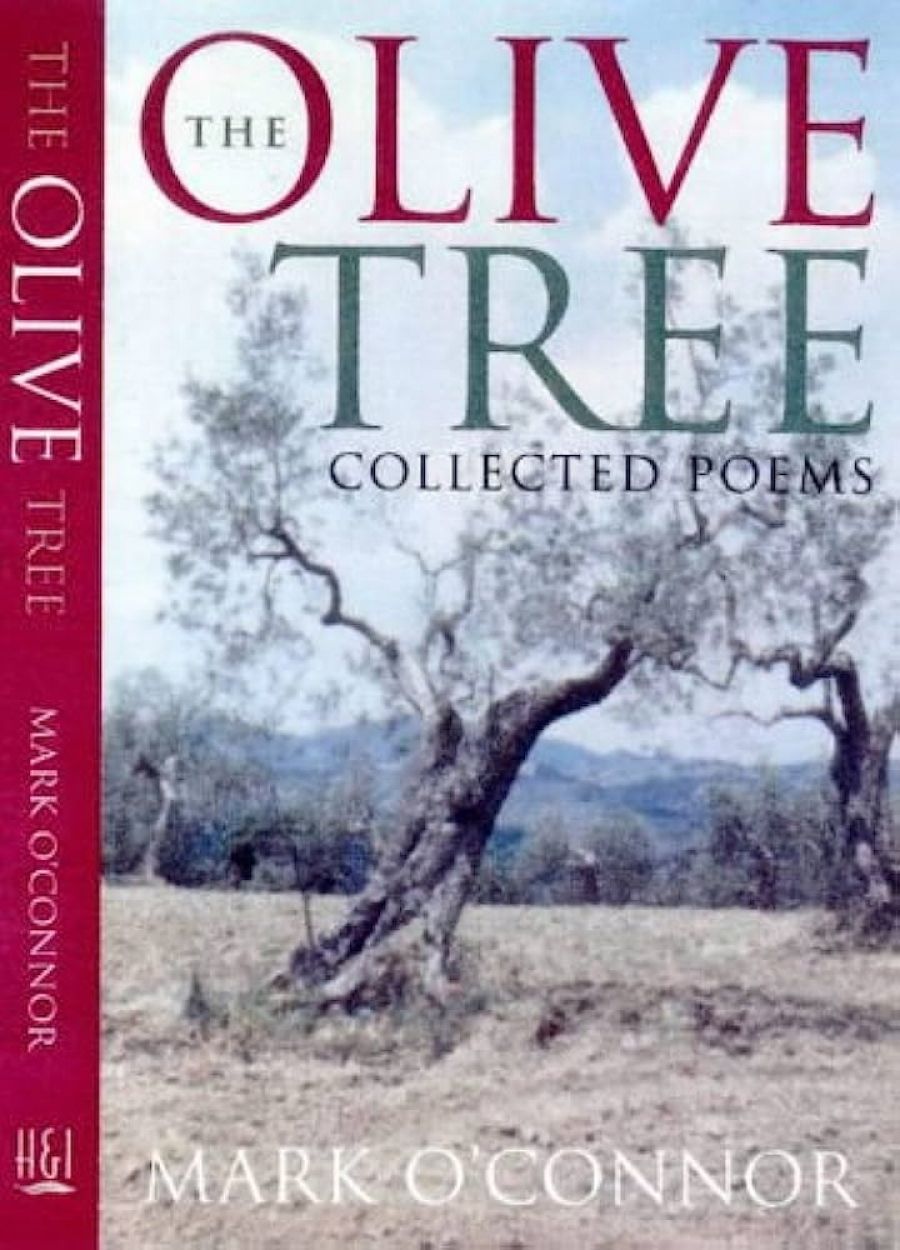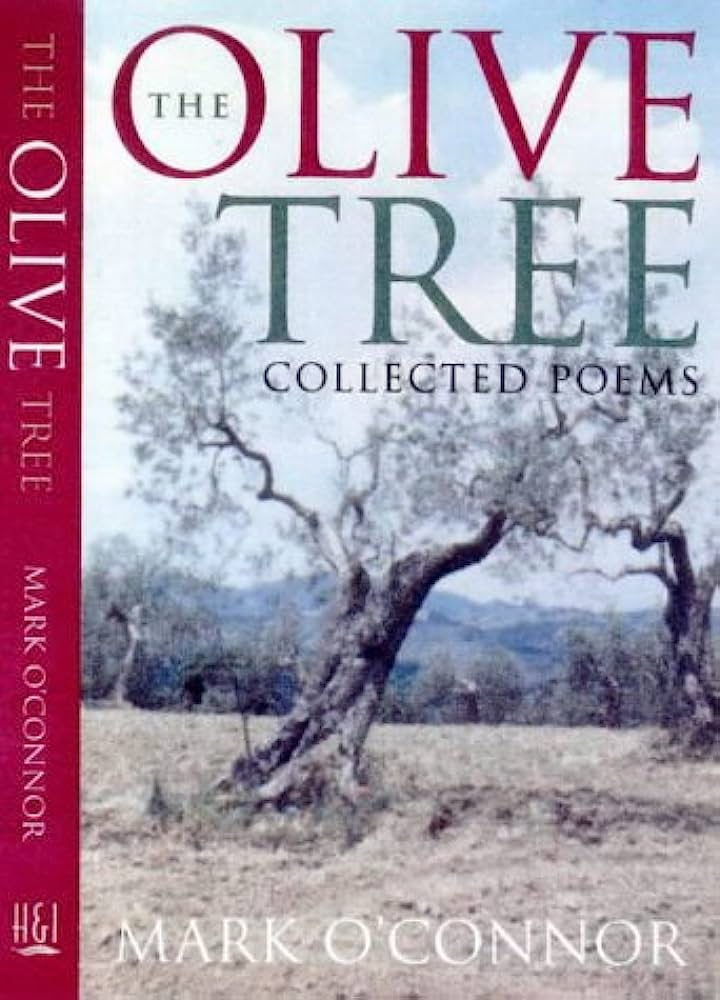
- Free Article: No
- Contents Category: Poetry
- Review Article: Yes
- Article Title: Mapping Australia
- Article Subtitle: Geoff Page
- Online Only: No
- Custom Highlight Text:
Mark O’Connor is a poet who has been in the news lately. Following in the steps of the ancient Greek poet, Pindar, he was appointed (by the Australia Council) as ‘official’ Olympic poet – though it seems inevitable that much of his work will concern only the Olympic flame on its way to the Games and the events to be seen on TV since neither SOCOG nor the Australia Council saw fit to give him a journalist's pass. Unfortunately, all this Olympic fuss has tended to obscure his work of three decades up to this point, a journey well represented in his recent The Olive Tree: Collected poems.
- Book 1 Title: The Olive Tree
- Book 1 Subtitle: Collected Poems
- Book 1 Biblio: Hale & Iremonger $27.45 pb, 272 pp
- Book 1 Cover Small (400 x 600):

- Book 1 Cover (800 x 1200):

In regard to his long-standing project, O’Connor has said: ‘I believe it’s more important – and in the long run more effective – to “name the parts” of a rainforest than to preach overt conservation.’ He has not hesitated to use precise scientific terms or even Latin names when I detected in them the ring of poetry. Unfortunately, some of the problems with his poetry arise out of this very naming out of the intention to ‘describe’, or at best ‘evoke’, rather than to dramatise.
Poems where there is a strong narrative interest or a dramatic human situation are relatively few; poems of a personal, ‘confessional’ nature are rare. O’Connor, through his own terms of reference, has often cut himself off from several of the most viable resources of poetry. Like the later Wordsworth, O’Connor, in his desire to ‘fit everything in’ can become over-discursive. There is another problem too in such a program of description, namely the anthropomorphic. I’m not sure, for instance, that the poet really gets away with referring to a lyrebird’s ‘two-stepping run’ as a ‘Robocop strut’. These sorts of images, with their often-jarring changes in tone and diction, can often serve to take us away from an animal’s (or landscape’s) true nature as much as they do to define it.
But these are perhaps small quibbles. There is much in O’Connor’s work to be enjoyed as well as to be instructed by. There is even a sense of humour from time to time, as in his playful and extended description of outdated surgical implements in ‘The Amiable Inquisition of the Surgeon’ or in the wry humour of some of his poems from Italy, particularly his ‘Riding a Hired Lambretta in the Fifth Lane of the Autostrada to Visit the Underworld’ which concludes ‘we passed the Avernus / Riding School and Bar, and the Stygian Tomato / Coop. Buy Lethe! The god’s last word: “Leave nothing in your car”.’
There is always with O’Connor, too, a sense of the ‘interconnectedness’ of the environment he is describing. While not seeming to believe seriously in a God who put it all together (though he does have a very diverting version of Genesis in his poem ‘The Beginning’) O’Connor can evoke, quite unsentimentally at times, the way nature works and our relatively small part in it. Lines such as ‘Today we know rainforest / is too busy to feel men passing through’ or ‘the real prize / in a jungle is not white flesh / but a place in the sun’ tell the story.
Another strength of O’Connor’s poetry is its awareness of Aboriginal culture and viewpoints and the way this knowledge is integrated into his overall program. Poems such as ‘Aboriginal Literacy’ and ‘Interview in a Desert’ show how his own conservationist values and those of most Aborigines tend to converge. In the latter an anthropologist’s tribal interlocutor says, when asked if there is any dreaming story associated with uranium:
Nah, dat proper useless Whitefeller rock.
Only good for kids go play.
We got no story who put im dere.
But Whitefeller go hunt dat yellow rock
to make im trade-bead. All day out in sun.
Poor bugga forget place where ’e born. Only look
for dat crazy rock. Dat Whitefeller totem:
we call dat Rock belong Jesus Dreaming.
As suggested earlier, O’Connor is often at his best when he most departs from his own program. His rare personal poems, ‘Revisiting Home Town’ and ‘The 14 Syllogisms of the Cross’ give an insight, unavailable elsewhere, into the person behind the objective describer we see so often through the rest of the book. The latter poem, for instance, is an extended meditation on what remains for a lapsed Catholic of his upbringing – and what is shed. He follows the paintings of the fourteen stations of the cross around his hometown church and concludes agnostically at last: ‘A story full and perfect in itself / vouched by its own participants // and no eye-witness but imagination.’
Likewise, his poems from the ‘Europe’ section also have considerable immediacy, as well as a strong sense of place, suggesting that O’Connor might equally well have been a travel writer if he had not chosen to commit himself to his poetic project at home. His thorough grounding in Latin shows in his appreciation of the Italian landscape and the relaxed Italian rural lifestyle. His poem ‘Meeting a Poet’ is written in easy iambics (rather than his usual free verse) and describes a meeting with what seems to be the ghost of a Latin poet who talks on amiably about Virgil, Horace, Ovid, Tibullus, and even Juvenal while enjoying ‘this view for which in Rome you’d pay / a billion lire’. This classical note is rare in contemporary Australian poetry and O’Connor, along with A.D. Hope and John Bray, has been one of the few to catch it precisely.
It is disconcerting but nonetheless true, that one of O’Connor’s most memorable and, in its own way, most typical poems is one of his earliest, namely the long narrative ‘Planting the Dunk Botanic Gardens’. This has all the evocative botany one finds in the other poems but it also has considerable narrative momentum as the poet traces his struggles with the obstacles to his great plan which include the weather, shortness of time, resort managers, errant bulldozer drivers, and other phenomena. At the end of fourteen pages the reader vicariously shares the poet’s achievement when the great work is finished and, despite the threat of new managers with plans for golf courses etc., O’Connor can say, ‘All was foreseen, and known / since gardeners are suspicious, patient; only / the trees go on growing in the mind.’
Those who have heard of O’Connor solely through the Olympic connection are strongly advised to consult this rich and well-organised selection of his work. There may be passages that seem exhaustively comprehensive and deliberate but there are also many slivers of ecological and human wisdom to be discovered here. Take, for instance, ‘Crocodile Haiku’: ‘How the river is enhanced / by the crocodile in it! / Each ripple astir with richer meaning.’ Or his compliment to the legendary Queensland beachcomber, E.J. Banfield: ‘learning through love / that Aboriginal trick, to leave the land / beyond their life untouched.’


Comments powered by CComment